The following is a travel story I wrote about my first chase experience, which was with Cloud 9 Tours in the spring of 1997. A shorter version of the article ran in the The Baltimore Sun in early 1998. The contents reflect the experiences of a novice who is also new to chase culture, and it’s written for a general audience that might be unfamiliar with chasing. The article is also divided into sections here for easier web-browsing.
Therefore, be advised that some of the contents may not reflect my current opinions or what any of the people mentioned herein are now doing (jobs, etc., may have changed). I have, however, snipped some verbiage from my original account. (Just think of it as the edited unedited version.)
Contents copyright 1997-1999 by Chris Kridler
It’s a May evening in the Texas panhandle, and daylight is running out. To the north, a towering storm cloud sprouts up and over our heads, hung with the little pockets of water vapor called mammatus, the hallmark of a violent storm. But that storm isn’t the one we’re after. We’re after the tornado.
We’re storm-chasing, and this, although we don’t know it, is the best chance we’ll have in a two-week tour to see a twister. Brilliant bolts of lightning are hitting nearby as our leaders jabber excitedly over the CBs, trying to figure out which storm to chase. South, we decide. We’ve been driving in huge circles all day, but finally, the reports on the radio indicate we might have a good one. Go south.
I grip the video camera, taking shots of orange clouds and lightning bolts out the passenger-side window of the Blazer and thinking about the soundtrack I’ll dub on later. Let’s rock and roll!
…..
Storm-chasing isn’t your average vacation. It’s not your average hobby, either. For the men and, occasionally, women who pursue it, it is nothing less than an obsession.
Long before “Twister,” I’d been fascinated by tornadoes, and I knew vaguely that storm-chasing tours existed after seeing Marty Feely’s Whirlwind Tours featured in TV specials. But chasing seemed a remote possibility until I did an idle Internet search at the technology pavilion on the Mall in Washington during the inaugural festivities in winter 1997.
Cloud 9 Tours came up. For a fee plus air fare, I could hang out with chasers on the Plains for two weeks and maybe, if I were really lucky, see a tornado.
Charles Edwards is the man in charge. A good-natured 30-something computer specialist at the University of Oklahoma in Norman, he would always rather be storm chasing. (Though he has many stickers on the back of his specially equipped Chevy Blazer — from NOAA to the Tasmanian Devil to Skywarn — none say exactly that.) He takes off work whenever the skies look promising, and for all of May and half of June, he devotes his time to running the small expeditions of Cloud 9 Tours.
This spring of 1997, it’s he and fellow chaser Steve Courton who meet me at the Oklahoma City airport. Charles is tall, rangy and quiet, while Steve chatters at length about the prognosis for “good” weather — the kind of weather the rest of Tornado Alley dreads. He and Charles discuss it further with Jim Leonard, a legendary tornado- and hurricane-chaser who meets us for lunch at what they affectionately call “the trough,” Furr’s Cafeteria.
As I will quickly learn, cafeteria-style lunches, truck stops, Mickey D’s and dreaded Allsup’s burritos are the norm for this bunch. No one goes storm-chasing for the food.
The guys think the forecast is grim, but they and the other chasers who will be lending a hand are still hopeful and excited that prime time has finally come: storm season. Seeing a tornado is fantastic, but it’s the process — the chase itself — that is everything.
First, however, Cloud 9 must await the arrival of the rest of the tourists. Unlike the usual customers, these are not weather junkies. These are a dozen Germans who have won “Twister” video sweepstakes, accompanied by two handsome blond journalists from Bild whom one of the chasers lightly refers to as “the Aryan guys.”
I get acquainted with my functional motel, the Guest Inn, and its adjoining Denny’s in Norman, Okla. My balcony view isn’t exactly romantic. It consists of a parking lot, some power lines and a dilapidated sign that once advertised an erstwhile Howard Johnson’s.
I’m adjusting to the landscape. It’s flat here. Really flat. But that’s why it’s so perfect for storms to develop — and for people to chase them. On the East Coast, the few tornadic storms move quickly and are hidden by trees and hills. On the Plains, where in the springtime, chilly air from Canada presses south to slam into warm, moisture-packed air from the Gulf of Mexico, the volatile mix cooks up severe storms. The most dramatic of these is the supercell, a forbidding storm with an area of rotation, or mesocyclone, that can be more than five miles across. It is the ideal hatchery for a tornado.
Chasers from all over the country are drawn to the Plains this time of year. While they don’t want to see a town razed by a twister, they definitely want to be there if one plows through a field.
The next day, Sunday, I get to see the University of Oklahoma’s beautiful Earth Sciences building, which has fascinating geology displays and, even more interesting to the weather freak, a “map room” full of computers where meteorology students look at weather data on the Internet to come up with dew points, wind speeds and direction and radar images that help them make their forecasts.
I kill the rest of the afternoon with Steve at the Oklahoma City Zoo, where most of the inhabitants of the new wild cat exhibit are napping and hiding from the paying customers. They are, after all, cats, and it’s excruciatingly hot. As we wait in line for a soda, I ask Steve what he does for fun when he’s not storm-chasing. “Uh, well, nothing really interesting,” he says. He thinks for a moment. “I can always chase hurricanes!”
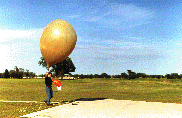 We return to Norman, a southern suburb of OKC, to see the evening launch of a weather balloon at the National Severe Storms Laboratory. Such daily launches provide the lab and its Storm Prediction Center with some of the data needed to predict severe storms.
We return to Norman, a southern suburb of OKC, to see the evening launch of a weather balloon at the National Severe Storms Laboratory. Such daily launches provide the lab and its Storm Prediction Center with some of the data needed to predict severe storms.
I go to dinner with a reporter and photojournalist from the Nashville NBC affiliate, Dennis Ferrier and Patrick Slattery, who will tag along with us for a week. We eschew cafeteria-style fast-food fare and eat at the Olive Garden. I’ve never been so happy to see Italian food in my life.
The gregarious Germans have arrived in two batches, one group via Vegas, and when I meet them, I suddenly feel like a foreigner in my own country. They know some English (certainly more than I know German), and from talking with them, I begin to realize two things: One, most of them don’t care much about storms; in fact, some of them haven’t even seen “Twister,” the raison d’etre for their trip. Second, they don’t really care if they find a tornado. They want to find Levis.
On Monday, I’m anxious for action. No such luck. We begin the sunny day looking at storm photographs lining the walls at NSSL, where we peer through a glass window at the forecasters in the Storm Prediction Center. (Unlike the lions at the zoo, they are not hiding.) The dramatic photographs of lightning and tornadoes only emphasize what we’re missing. So instead of chasing tornadoes, we chase bison.
Our caravan of two rented passenger vans, photographer Lan Lamphere’s van and the Nashville TV crew’s rented four-by-four set out for the Wichita Mountains Wildlife Refuge in southwestern Oklahoma. There, buffalo — descended, ironically, from animals purchased from the New York Zoological Society in 1907 after their near-extinction — roam as once they did all over the plains. They are roaming pretty far from us, though. We stop, and one grouchy animal lumbers across the lonely road as we hover nervously by the vehicles, snapping pictures.
We drive to the top of Mount Scott. Charles calls it “the top of Oklahoma.” The top isn’t very high, but it sure is beautiful. Rugged rocks surround us, and sapphire-blue water sparkles in the green-and-brown landscape below.
On our way back to Norman, we stop at a souvenir shack to get something to drink and see the main attraction, a sad-looking rattlesnake in a cage. If this weather keeps up, it’s going to be a long trip.
That night, I join half of the Germans for dinner. Lan, acting as Cloud 9’s official videographer, drives. He runs Windchaser, a company that specializes in photography. Bitten by the bug, he’s just picked up and moved his whole family to Norman from Alabama so that he can concentrate on storm-chasing.
At a local bar, we meet another chaser, Matt Biddle, a veteran of VORTEX (Verification of the Origins of Rotation in Tornadoes Experiment) and the entrepreneur behind Moderate Risk Chase Services, which escorts media crews on chasing junkets and sells T-shirts. It’s not exactly Trump Enterprises, but it’s a way to help defray the costs of chasing, which can be a very expensive hobby. I’m struck by how close this community is. For its denizens, talking about the weather isn’t just idle chit-chat.
At last, the tempest
May 6: A chase day. Finally! Our forecasters aren’t making any promises, but it looks as if there could be storms firing in the Texas panhandle. We set out on the long trip toward Amarillo.
I’m in the Blazer with driver Matt Moreland, a meteorology grad of OU. The other tourists are in the two vans, which Charles and Steve are driving; Lan, the Nashville news team and another NBC team from Alabama fill out the rest of the entourage. It’s starting to look like the caravan in the tornado thriller “Twister.” All we’re missing is Helen Hunt and Bill Paxton.
Hours of driving follow. This is the part of the chase that is not for the faint of heart — the boredom. I happen to love looking at meadows, fields, and little towns with their grain silos and Dairy Queens, and even more, gazing at the clouds, trying to decipher the puzzles they contain. I learn a lot from Matt about storm structure and formation as we drive toward the area where we hope storms will develop.
The prospects get better and better as we go west. Charles and Steve plug in at truck stops and check the latest data, using laptop computers to access the many sources of information available on the Web. Charles also has a satellite dish that he hooks up during stops to see the latest radar and reports on The Weather Channel.
Chasers have a love-hate relationship with the Weather Channel, much as they do with the movie “Twister.” The movie has brought them a lot of attention, and they get a kick out of quoting its more outrageous lines, but they’re constantly talking about how stupid it is. After all, we haven’t seen one tornado yet, let alone six in one day, like the “Twister” crew.
We are seeing a storm, however, for the first time, and a tornado watch has been issued for the area. We stop along U.S. 287 in the Oklahoma panhandle to watch distant downpours and spectacular lightning bolts. “That’s the only thing that scares me about storm-chasing — lightning,” Steve says.
The clouds are roiling overhead. The chasers are worried that storms to the south of us will cut off moisture to this storm. Soon, we are overtaken by rain, and set off toward Boise City. Intriguing “scud clouds,” the sort that provoke false tornado sightings, hang overhead. In front of us, a storm’s updraft base hangs low, dark and ominous over the road. We stop almost directly under the most amazing structure yet, an enormous rotating column of cloud. Lightning is striking very close, and Charles warns people to stay in the cars. The chasers get out, of course, and I do too, but I’m more cautious and stick close to the Blazer.
“If this were in a slightly better environment, we’d probably have a good wall cloud hanging down,” Matt says. (A wall cloud, which lowers from a rotating storm, is the most likely place for a tornado to occur.)
The cloud spins above us, a spiral staircase to the heavens. It’s eerie, scary — and fascinating.
Hail and rain begin to come down, and we jump back into the vehicles. The hail pounds loudly on the roof. It sounds like it’s raining rocks.
Just as we’re about to pull away, celebrity storm chaser Warren Faidley, who’s been featured on the Weather Channel and in TV documentaries, pulls up in front of us. His license plate reads “CU IN OZ” (the “CU” isn’t just a play on “see you,” but is an abbreviation for cumulus clouds).
Like many prosperous men — the success of his company, Weatherstock, allows him to call himself “the world’s only full-time professional storm photographer” — Faidley takes flak from some insiders even while outsiders regard him with awe. The word in chaser circles is that Jonas, the arrogant chaser in “Twister,” was based on him. Whatever the truth, we don’t stop to say hello.
As we try to get ahead of the storms to get a better vantage point, we see a glowing veil of white, pouring down from a storm to our west, with a low, dark cloud draped in front and an orange sky behind. I have never seen anything so beautiful. It’s a hail shaft, Matt tells me: a rush of light-reflecting hail descending from the storm.
It’s sunset, as it often is when storms are reaching their peak. That’s the time when the day’s heating has done its work, creating enough lifting energy to produce the cloud “towers” that in turn produce storms. Storms with strong updrafts are also likely to produce hail, as supercooled water droplets are lifted into the cold, upper part of the storm, gaining as many as 25 layers of ice as they are churned through layers of varying temperature and humidity. When the ice particles become too heavy to be lifted, they fall as hail.
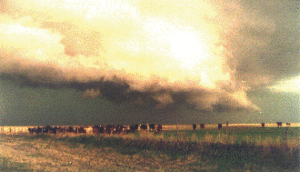 We stop twice in front of what has become a rapidly advancing gust front, a gloomy, undulating line of storm that isn’t likely to produce a tornado but is very likely to spit out hail and rain and fierce winds. It’s on top of us in a just a few minutes each time, sending the cows before it stampeding.
We stop twice in front of what has become a rapidly advancing gust front, a gloomy, undulating line of storm that isn’t likely to produce a tornado but is very likely to spit out hail and rain and fierce winds. It’s on top of us in a just a few minutes each time, sending the cows before it stampeding.
Night is looming, and Matt and I are given orders to “punch the core” of the storm — drive into its hail-filled and gale-twisted heart — while Charles, Steve and the rest seek shelter in Stratford, in the northern Texas panhandle. Charles has attached a hail shield of his own invention to the Blazer, and he’s eager for us to try it out.
Matt drives us straight into the gust front, and the sudden darkness is almost as amazing as the noise from the wind, rain and, soon enough, hail. It’s time to deploy the shield: We roll down our windows, stick our arms out, and are thoroughly pelted by hailstones while we flip the cage-like shield down over the windshield from its mount on the roof. The hail stings like hell, but it’s also hysterically funny. We can’t see a thing, except the lightning bolts striking all around us, and the noise is deafening.
I love it.
We turn around and catch up with the gang at a gas station in Stratford. Then: a tornado siren. My first. I’m nervous. No one seems to know what’s really going on, but the veteran chasers, talking on the CBs, are pretty sure the storm we just went through was unlikely to produce a tornado. “Probably one of those radar-indicated mid-level rotation things,” Steve says confidently. It’s little comfort that the hysterical woman running the convenience store locks everybody out after the siren’s wail. What a humanitarian!
After the adrenalin rush, no twister materializes. We set out for a Motel 6 in Amarillo on hail-coated roads, treated to a lightning display better than any fireworks. We stop to take a few shots, mindful that these fireworks, if you’re not careful, will turn you into toast.
The lone tornado
May 7 begins with a “moderate risk” of severe storms forecast by the Storm Prediction Center. Moderate-risk days are chasers’ favorites; while chances are reasonable that severe storms will develop, they aren’t jinxed by a “high risk” forecast. Chasers are superstitious that way.
Our forecasters have decided that Turkey, Texas, will be the best place to see some action. We begin the trek southeast through the panhandle, with a stop in the scenic Caprock Canyons. Outside of Turkey, we hear on the radio that a watch box has been issued, and we’re near the southern end of it. While chasers will tell you they don’t chase tornado watches, they still take them seriously. We head east and hear that tornadoes are hitting in Kansas and Oklahoma, too far north for us to contemplate. So we stop in Childress to think things through.
We aren’t alone.
 It’s Chaser Convergence, a common phenomenon when serious storm-chasers are after the same storm systems. VORTEX goes through. Matt Biddle’s decal-clad El Camino pulls in, though it appears someone else is driving. Marty Feely appears with one of his Whirlwind Tours. Jim Leonard and Casey Crosbie show up.
It’s Chaser Convergence, a common phenomenon when serious storm-chasers are after the same storm systems. VORTEX goes through. Matt Biddle’s decal-clad El Camino pulls in, though it appears someone else is driving. Marty Feely appears with one of his Whirlwind Tours. Jim Leonard and Casey Crosbie show up.
Tourists and chasers sit around for hours, drinking sodas and watching the Weather Channel. We hear that storms are firing where we were yesterday, too far away for the amount of daylight we have left. We head north and end up going west — back toward Amarillo — even as we hear that storms are indeed going up in Turkey, our original destination.
It would be funny if it weren’t so frustrating.
But the storms, to our north and south, are dramatically lit by the setting sun even as they spew lightning all around. We take a chance and head south, encouraged by what we hear on the radio. The rolling landscape in this part of Texas is now our worst enemy; just after we turn north again, we see it — in between hills — a distant tornado to our west. I videotape, not sure it’s a tornado at all. But the tape proves that, north of Clarendon, we indeed caught a glimpse of a twister.
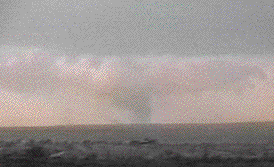 It breaks apart as we stop to watch the advancing storm.
It breaks apart as we stop to watch the advancing storm.
Then we hold our breath as its wall cloud shows obvious rotation.
We are all videotaping compulsively — well, those of us with video cameras, anyway. A running joke is the “stormgasms” that excited chasers come up with as they are videotaping extraordinary weather. If you rent or buy some of the many videos on the market — the best are in the “Tornado Video Classics” series — you’ll hear what I mean. I haven’t mastered the art yet. On my video, I say “wow” a lot.
We take shelter inside the cars as the lightning gets closer. The sun is setting behind the storm, a fearsome orange, as a new area of rotation begins to kick up some dust from the ground. “That’s a really nice meso spinning up there,” Charles says over the CB. Country music plays on the radio as the chasers try to guess what the storm will do. This might be an “F0” tornado, as Matt Moreland calls it — but because it soon dissipates, we hesitate to give it the title. Still, the storm is dynamic and awe-inspiring as it rushes toward us.
Again, the rest of the caravan seeks shelter as Matt and I, joined by a member of the Alabama TV crew, punch the core. This time, we’re hammered by golf-ball-size hail. And the drive south to join the others is among the most memorable, as we follow the towering storm as it shimmers with lightning and glows with the orange and blue colors of sunset.
Heading back to Amarillo, we’re treated to another spectacular lightning show in the east, of CGs (cloud-to-ground strikes) and anvil crawlers (which stretch across the clouds). In the west, the skies are clearing, and Comet Hale-Bopp shines ethereally in the velvet darkness. The CBs are nearly quiet. Everyone is tired and humbled after a day of experiencing nature at its most powerful and enthralling.
The wind’s roar
The day dawns gray at the Motel 6, but Lan and Matt don’t much care. They have a hangover.
“I just want somebody to slap me,” Matt jokes.
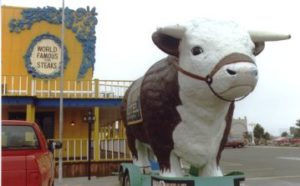 Steve and Charles discuss whether to chase. It’s a “slight risk” day. We decide to give it a shot, but first, a visit to an Amarillo landmark: The Big Texan. A colorful tourist trap, the restaurant-hotel-gift shop complex is designed to look like an Old West town. A elephant-size fake cow guards the front door. A sign tells us that if we can eat a 72-ounce steak in an hour, it’s free!
Steve and Charles discuss whether to chase. It’s a “slight risk” day. We decide to give it a shot, but first, a visit to an Amarillo landmark: The Big Texan. A colorful tourist trap, the restaurant-hotel-gift shop complex is designed to look like an Old West town. A elephant-size fake cow guards the front door. A sign tells us that if we can eat a 72-ounce steak in an hour, it’s free!
We don’t have that kind of time. We head out in search of hailstorms.
In the Blazer, Matt and I and two of the Germans split from the rest of the group in hopes of sampling some big hail in north Texas. On a desolate little farm road, we talk to a storm spotter. Then Matt calls a friend in Norman to get the latest data. It looks like the biggest hail is to our west, but we decide to see what we can see. We drive toward a storm that’s all motion and “greenage,” bilious and mean. We park on a side road and await the monster.
It kicks up dust from the ground, at first, and Matt assures me that we’re not looking at a tornado. It’s a powerful gust front, and soon the car is rocking in fierce winds and horizontal rain. It looks like a hurricane is blowing by.
When the worst is over, we make our way back on partially flooded farm roads to the highway and see a fence blown down near Vernon, Texas, and a tractor-trailer on its side on the highway, indicative of hurricane-force winds — possibly 75 miles per hour. It obviously doesn’t take a tornado to do damage.
It turns out the rest of the caravan was caught in the winds, too. We meet them and drive on to Dallas, amid tornado warnings on the radio and yet another lightning show. It will take a few days for the atmosphere to replenish itself with moisture; until then, it’s playtime in the big city.
The plunge
The grassy knoll looks a lot bigger on TV.
We are doing the Dallas tourist thing, and I’m impressed by the history of the Kennedy assassination as put forth in the Sixth Floor Museum in the old book depository at Dealey Plaza. You can see the whole tableau from this vantage point, and, because it has been re-created so often in popular culture, it resonates strangely before the naked eye.
We move on to the sky-high view from Reunion Tower, then shop at the Galleria. It’s all very loud and glitzy and artificial after our days on the windswept plains.
Still, the adrenaline hasn’t completely worn off. At the Six Flags amusement park the next day, when Charles and Lan want a partner to join them in the bungee-type plunge in Dive Bomber Alley, I find myself saying yes and then spend the entire time leading up to the fall telling myself how crazy I am. We are tricked out in harnesses, hooked together and hoisted up 10 stories, very slowly. “I’m so scared,” I squeak. Everything looks really, really tiny from up here. Fortunately, Lan is in charge of the rip cord. This is going to happen whether I want it to or not.
The countdown comes over the speaker. Lan pulls the cord and —
Nothing happens.
By the time they’ve lowered us, readjusted us and hauled us back up again, I’m beyond fear. When Lan pulls the cord, there are a few seconds of free-fall terror and then the exhilaration of flying, as we soar out over the crowd and back again.
The next morning, some of the Germans make friends with an officer from the Euless, Texas, police station. We’re invited on a tour before we head back to Norman. Several in the group gleefully squeeze into a jail cell, under the baleful stares of real inmates. Charles is handcuffed, to everyone’s amusement. This is what storm-chasers do in their off time?
The following day, with the weather still annoyingly fair, we leave Norman for a visit to Wakita, Okla.
If you’ve seen “Twister,” you’re familiar with Wakita as the home of Aunt Meg and the site of some nasty devastation. The filmmakers bought up part of the main street, fixed up some hail-damaged buildings and then knocked them down in a swirl of debris to mimic the passage of a tornado. Now, in a faux auto parts store that was the location office for the filmmakers, the “Twister” Museum shows visitors relics from the movie, including sculpture by Aunt Meg, a video of her house being destroyed (twice), and a shrine to Bill Paxton. (Apparently he made more friends than his co-star.) We also get to see one of the movie’s original “Dorothy” machines, temporarily on loan to the museum.
We’re invited to take bricks from the last pile of debris on the street. I love a town that lets you take away its debris for absolutely no charge.
We stop at some outlet stores on the way back to Norman so that the Germans can continue their quest for blue jeans. I walk to a neighboring wheat field and take pictures of the young, green stalks. They ripple in a gentle breeze. It’s very quiet. And no storms are in sight.
The bad, the beautiful
Most of the group goes horseback riding the following day, May 13, while a few of us decide to take a chance on a slim forecast and drive to northern Oklahoma to stare at a few white clouds.
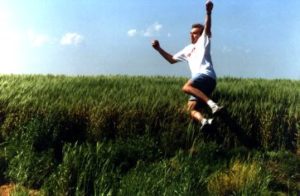 Along a road that looks like Prairie Stop in “North by Northwest,” The Bild reporter tries to melt his ice cream. The Bild photographer snaps pictures. Casey makes phone calls and jumps into a wheat field. Charles plays with his web site and computer games. Steve stares at the sky. Another German journalist, who has joined us for just a couple of days, sits in a dusty gully. I throw a little balsa-wood plane and run to retrieve it, only to screech to a halt in front of an enormous snake. We all gather around. It’s a rattler, all right, but it’s lost its rattle. After some rather foolish teasing by Steve, it slithers off into a wheat field.
Along a road that looks like Prairie Stop in “North by Northwest,” The Bild reporter tries to melt his ice cream. The Bild photographer snaps pictures. Casey makes phone calls and jumps into a wheat field. Charles plays with his web site and computer games. Steve stares at the sky. Another German journalist, who has joined us for just a couple of days, sits in a dusty gully. I throw a little balsa-wood plane and run to retrieve it, only to screech to a halt in front of an enormous snake. We all gather around. It’s a rattler, all right, but it’s lost its rattle. After some rather foolish teasing by Steve, it slithers off into a wheat field.
So much for storms.
The next day, at last, we have something to chase. We end up west of Abilene, with towers going up to our north and west. It looks as if someone has declared nuclear war on the Texas panhandle. A large, crisp anvil — the rounded, flat crown of ice crystals blown off the top of the storm — looms in front of us, filtering the sun. We know we’re not going to see a tornado, so we stop for a hurried conference by the side of the road. We decide to sample some hail, and choose a storm.
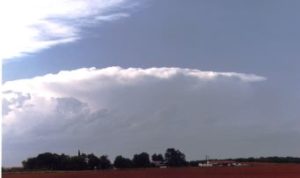 We end up between the storms instead, and they are the most dazzling of the trip. Serendipity guides us. The fabulous sunset sets afire both monster clouds, as rain hangs like feathery mist from their dark bellies. Mammatus clouds glow orange, and lightning forks to the ground and crawls across the sky. A breeze carrying fresh, brisk air whisks through our group. Charles and Lan set up cameras and shout ecstatically when the lightning bolts cooperate with their shutters. I take pictures until I run out of film.
We end up between the storms instead, and they are the most dazzling of the trip. Serendipity guides us. The fabulous sunset sets afire both monster clouds, as rain hangs like feathery mist from their dark bellies. Mammatus clouds glow orange, and lightning forks to the ground and crawls across the sky. A breeze carrying fresh, brisk air whisks through our group. Charles and Lan set up cameras and shout ecstatically when the lightning bolts cooperate with their shutters. I take pictures until I run out of film.
As night falls, on the way to yet another Motel 6 in Lubbock, we stop to view a stupendous sight: an LP (low-precipitation) rotating storm. It is dark, cool and windy, but a slender moon dimly lights the striated clouds, and the anvil cuts a disclike edge into a clear, starry sky. For a moment, it looks as if the storm has lowered a wall cloud, and Lan and Casey drive off to get under it in a frenzy of excitement. The lightning illuminates it only rarely, but we are all tense for a few moments, thinking it may produce a tornado.
It doesn’t. As the storm loses its structure, we drive away, and it follows us like the figurehead of a ship, a giant mermaid lit by the stars and the moon, her hair and tail streaming behind. Lightning sparks from her base as she flies, a giantess of air, vapor, mystery and power.
The Germans mutiny; they want to return to Norman to spend a last evening together before half the group departs.
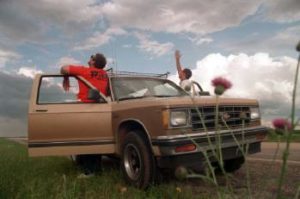 So the next day, Casey takes me and another hanger-on, Allan Rosenberg, storm-chasing. Allan, a lawyer, is the creator of a storm-chasing comic that is only available on the Web.
So the next day, Casey takes me and another hanger-on, Allan Rosenberg, storm-chasing. Allan, a lawyer, is the creator of a storm-chasing comic that is only available on the Web.
Our luck is not good. We pass through a minor storm coming out of Lubbock, and the only rotation we see all day is a dust devil. But as we drive across austere, open land in north Texas, the sky is like a meteorology class, full of variety and beauty, and the roadsides are profuse with wildflowers. And somewhere, on a lonely road outside nowheresville, we see a rainbow.
Back in Norman, I visit with my fellow tourists for a while before succumbing to exhaustion. Steve, a brilliant mind but not a brilliant cruise director, has quit the tour after being driven to distraction by the Germans.
The last chase
On May 16, as the tour winds down, I fear I will never see another storm. Charles doesn’t deem a slight chance of action in Kansas worth going after, so with the remaining half of the group, we go to the local putt-putt.
After a game, some go-karts and other amusements, Charles’ cell-phone starts ringing. Storms are going up in Kansas, and every chaser in Norman is on the phone. For tomorrow, SPC has put out a moderate risk for severe thunderstorms and possibly tornadoes in northern Kansas and Nebraska.
The chasers immediately snap into action and stand around in the hotel parking lot talking for three hours.
The Germans aren’t interested in going, but I am. Charles enlists Allan as a backup driver, and we finally head north. We end up in Salina, Kansas, where several other chasers have converged, and park next to a gigantic slice of pizza. (It’s on a trailer, promoting the Tombstone brand.) At the hotel, SPC’s web site has bad news for us: the moderate-risk area has shifted up into Minnesota. My tour is almost up, and there’s no way to get there and back in one day. We decide to play a slight-risk area in the morning.
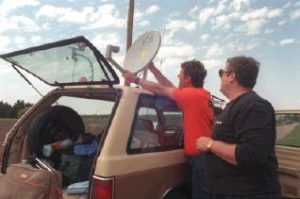 This is how the tour ends, not with a bang, but a whimper. Up into Nebraska we drive, then back down through Kansas, catching some minor storms on the way back to Norman. Charles is frustrated. I’m frustrated. Allan might be frustrated, but he’s not saying.
This is how the tour ends, not with a bang, but a whimper. Up into Nebraska we drive, then back down through Kansas, catching some minor storms on the way back to Norman. Charles is frustrated. I’m frustrated. Allan might be frustrated, but he’s not saying.
Tours like this are notoriously unpredictable. The second session of Cloud 9’s tours, which follows mine, sees nine tornadoes in two days over Memorial Day weekend. Nine in two days! That’s almost “Twister” frequency.
That tour group also is a witness to the deployment of the DilloCam. Built by Charles, it’s a low-profile, mostly lead casing for a video camera designed to be placed in the path of a twister — and Casey deploys it in the path of a big wedge tornado. The video is grungy and pretty impressive.
Chasers spin the wheel of fortune, and in one of every 10 chases, a tornado spins out of the clouds.
